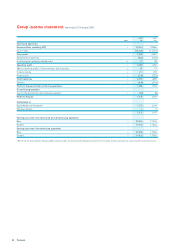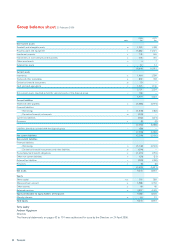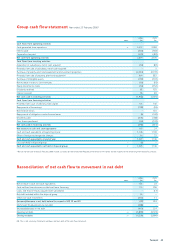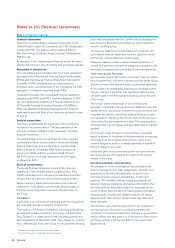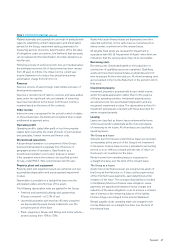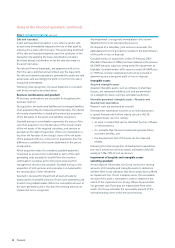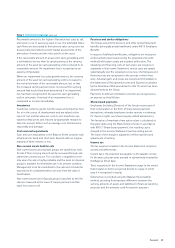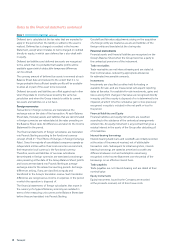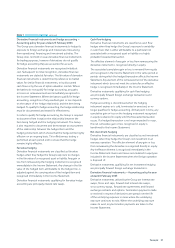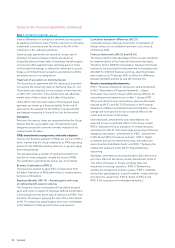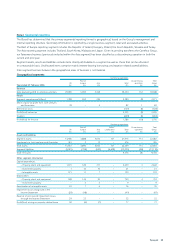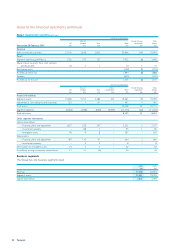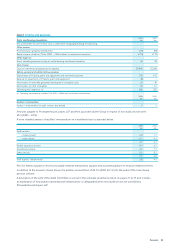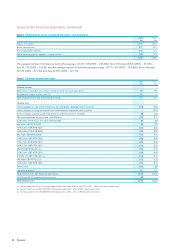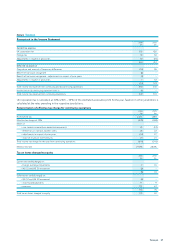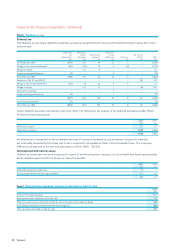Tesco 2006 Annual Report Download - page 54
Download and view the complete annual report
Please find page 54 of the 2006 Tesco annual report below. You can navigate through the pages in the report by either clicking on the pages listed below, or by using the keyword search tool below to find specific information within the annual report.
52 Tesco plc
Notes to the financial statements continued
Note 1 Accounting policies continued
Interest differentials on derivative instruments are recognised
by adjusting net finance costs. Premia or discount on derivative
instruments is amortised over the shorter of the life of the
instrument or the underlying exposure.
Currency swap agreements are valued at closing rates of
exchange. Forward exchange contracts are valued at
discounted closing forward rates of exchange. Resulting gains
or losses are offset against foreign exchange gains or losses
on the related borrowings or, where the instrument is used to
hedge a committed future transaction, are deferred until the
transaction occurs or is extinguished.
Treatment of put option on minority interest
The Group has an agreement with the Samsung Corporation
to purchase the remaining shares of Samsung Tesco Co. Ltd.
Theseshares are expected to be purchased in three tranches
in 2007, 2011 and 2012. The purchase price will reflect the
market value of these shares at the date of acquisition.
Under IAS 32, the net present value of the expected future
payments are shown as a financial liability. At the end of
each period, the valuation of the liability is reassessed with
any changes recognised in the profit or loss for the period.
Provisions
Provisions for onerous leases are recognised when the Group
believes that the unavoidable costs of meeting the lease
obligations exceed the economic benefits expected to be
received under the lease.
IFRSs transitional arrangements and early adoption
The rules for first-time adoption of IFRSs are set out in IFRS 1,
which requires that the Group establishes its IFRS accounting
policies for the 2005/06 reporting date and, in general, apply
these retrospectively.
The standard allows a number of optional exemptions on
transition tohelp companies simplify the move to IFRSs.
The exemptions selected by the Group are set out below:
Business Combinations (IFRS 3)
The Group has elected to apply IFRS 3 prospectively from
the date of transition to IFRSs rather than to restate previous
business combinations.
Employee Benefits (IAS 19) – Actuarial gains and losses
on defined benefit pension schemes
The Group has chosen to recognise all cumulative actuarial
gains and losses in respect of employee defined benefit plans
in full through reserves at the date of transition to IFRSs. Post-
transition, the Group is applying the rules of the amendment
to IAS 19, recognising actuarial gains and losses immediately
in the Statement of Recognised Income and Expense.
Cumulative translation differences (IAS 21)
Cumulative foreign exchange movements on translation of
foreign entities on consolidation have been set to nil as at
29 February 2004.
Financial Instruments (IAS 32 and IAS 39)
The Group opted to take advantage of the one-year exemption
for implementation of the Financial Instruments standards.
Therefore, for the 2004/05 comparatives, financial instruments
continue to be accounted for and presented in accordance with
UK GAAP. For 2005/06 financial reporting, adjustments have
been made as at 27 February 2005 to reflect the differences
between UK GAAP and IAS 32 and IAS 39 (note 33).
Recent accounting developments
IFRS 7 ‘Financial Instruments: Disclosures’ and amendments
toIAS 1 ‘Presentation of Financial Statements – Capital
Disclosures’ were issued in August 2005 and are effective for
accounting periods beginning on or after 1 January 2007.
Theseamendments revise and enhance previous disclosures
required by IAS 32 and IAS 30 ‘Disclosures in the Financial
Statements of Banks and Similar Financial Institutions’. These
changes are not expected to have a material effect on the
results and net assets of the Group.
Other standards, amendments and interpretations not
expected to have a significant effect on the Group include:
IFRS 6 ‘Exploration for and evaluation of mineral resources’,
amendment to IAS 39 ‘Cash flow hedge accounting of forecast
intragroup transactions’, amendment to IFRS 1, amendment
toIAS 39 and IFRS 4 ‘Insurance contracts’, IFRIC 5 ‘Rights
to interests arising from decommissioning, restoration and
environmental rehabilitation funds’ and IFRIC 7 ‘Applying the
restatement approach under IAS 29 ‘Hyperinflationary
accounting’.
Standards, amendments and interpretations still under review
as totheir effect on the Group include: Amendment to IAS 21
‘The effectof changes in foreign exchange rates: net
investment in a foreign operation’, IFRIC 4 ‘Determining
whether an arrangement contains a lease’, IFRIC 6 ‘Liabilities
arising from participating in a specific market – waste electrical
and electronic equipment’, IFRIC 8 ‘Scope of IFRS 2’ and
IFRIC 9 ‘Re-assessment of embedded derivatives’.


